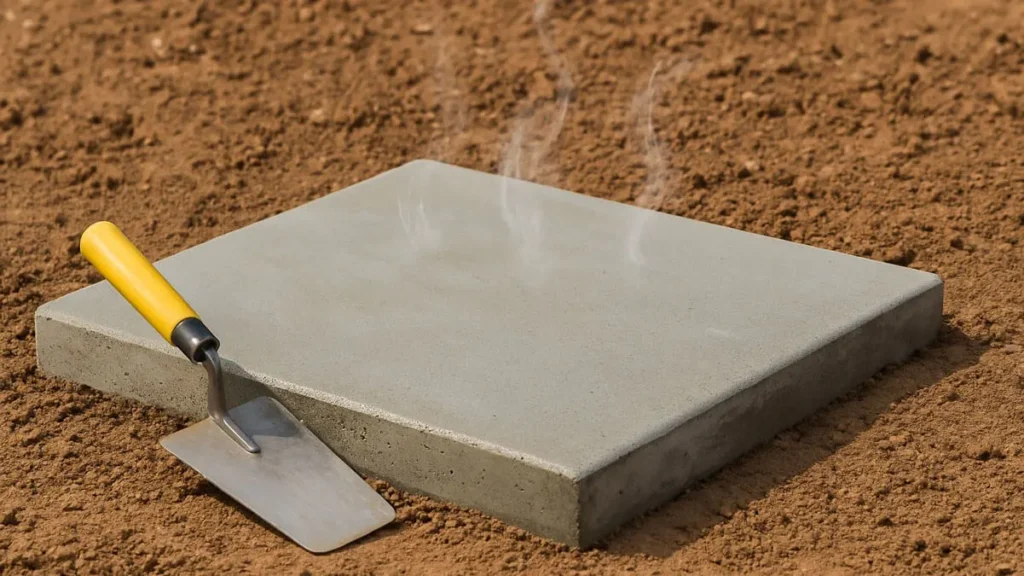How Long Does Concrete Take to Dry


Instant concrete drying is not possible, and for anyone who is working on a building or home project, it is important to know how long it takes to fully set. No matter if it’s a small slab, a driveway, or a large foundation, knowing how long does concrete take to dry helps you to plan each step carefully. Drying time affects when you can walk on it, build on it, or apply finishes. Rushing the process can lead to cracks, weakness, or costly do-overs. That’s why it’s important to know what’s really happening while concrete cures.
The Difference Between Drying and Curing
When someone says concrete is “dry,” it often means the surface feels firm or hard. But concrete doesn’t just dry—it cures. Curing is a chemical process called hydration. This happens when cement in the mix reacts with water and forms crystals that give concrete its strength. Even if the top feels dry, the inside could still be wet and weak.
Curing continues for many days after pouring. It doesn’t stop as soon as the concrete feels solid under your feet. In fact, even after a week, the concrete might still be gaining strength. That’s why it’s important to wait the proper amount of time before adding heavy loads, structures, or finishing materials.
The First 24 to 48 Hours
Right after pouring, concrete begins to set. Within the first 24 hours, the surface starts to harden. During this time, it’s important to protect the area from rain, strong wind, or extreme heat. Even footprints or tool marks can ruin the finish. Most contractors avoid walking on the surface during this stage.
By the 48-hour mark, the top layer of concrete is usually strong enough to support light foot traffic. This does not mean the concrete is fully dry, but it can handle minor weight if necessary. However, it’s still important to be careful. Heavy items like furniture or equipment should stay off until more time has passed.
Reaching Partial Strength by One Week
After about seven days, concrete reaches around 70% of its full strength. At this point, some light vehicles can drive on a slab, and you may begin minor construction on top of it. Still, any deep anchoring, drilling, or full use should be avoided. The concrete is strong, but it has not fully cured.
If the weather is cool or damp, the process may take longer. Concrete cures slower in low temperatures or shaded areas. It’s also affected by wind and sun. Hot weather can cause the surface to dry too quickly, leading to cracks unless it is kept moist.
Full Cure Time at 28 Days
Most concrete reaches full strength at 28 days. This is the standard rule in construction and engineering. By this point, the curing process has slowed down, but the material has achieved its intended durability. If the job involves heavy machinery, foundation building, or structural loads, waiting the full 28 days is critical.
During this month-long curing period, the concrete continues to bond and develop strength from the inside out. The surface may appear fully dry much earlier, but the inner layers are still adjusting. That’s why experts recommend waiting the full time before sealing the surface or beginning other finish work.
Things That Affect Drying and Curing Time
Concrete drying time depends on many factors. The weather is one of the biggest. In warm, dry weather, concrete may harden faster on the surface. But this doesn’t mean it’s fully cured. Moisture can still be trapped inside.
The mix itself also plays a role. If there’s more water in the mix, the concrete may take longer to dry. Some projects use quick-drying cement, but even those need several days to cure properly. Additives and chemical treatments may speed up surface drying, but they don’t replace natural curing time.
Project size and thickness matter too. A thin slab may cure faster than a thick foundation, especially if it’s exposed to air on all sides. Deeper pours hold more moisture and take longer to set all the way through.
Keeping Concrete Moist During Curing
One of the most important parts of curing is keeping the concrete moist. If the water in the mix dries out too quickly, the chemical reaction stops early. This weakens the final product. To prevent this, workers often cover concrete with plastic sheets, wet burlap, or apply a curing compound that traps moisture.
Spraying the surface lightly with water during the first week can also help. This is especially important during hot or windy weather, when evaporation speeds up. By maintaining moisture, you ensure that the curing process continues as it should and the final strength of the concrete is reached.
When to Seal or Paint the Surface
Sealing concrete protects it from moisture, stains, and wear. But sealing too soon can trap water inside and cause problems later. Before sealing, the concrete must be fully dry. For most surfaces, this means waiting at least 28 days after pouring.
Painting concrete also requires a fully dry surface. If you apply paint or stain before the concrete is cured, it may peel, bubble, or fade quickly. Always follow product directions and wait the full curing time before applying any finish.
Testing for Dryness
If you’re unsure whether the concrete is dry, you can do a simple test. Tape a square of plastic film to the surface and leave it for 24 hours. If moisture collects under the plastic, the concrete is still drying. Wait a few more days and test again before sealing or building.
There are also moisture meters available, but they can be costly. For most home projects, the plastic test gives a good idea of the moisture level without needing special tools.
Planning Your Project Timeline
Knowing how long does concrete take to dry allows you to schedule your work properly. Don’t plan heavy use of the area the next day or rush to finish everything at once. Allow each stage enough time to set fully before moving forward. Doing this keeps the job on track and reduces the chance of failure.
Create a simple timeline based on your concrete type and size. Include waiting periods for curing, finishing, and sealing. If the weather turns bad, be ready to pause and give the concrete more time to cure. A little patience goes a long way in protecting your work.
Read more: How to Hire Labor for a Construction Site?
Getting the Best Result
Concrete is a strong and reliable material, but it depends on time and care. It does not dry in a day, and rushing the process leads to cracks, chips, and wasted money. By understanding the curing stages and watching the weather, you can make sure your concrete performs well for years to come.
Whether you’re working on a home project or managing a construction job, knowing how long does concrete take to dry is one of the most important parts of the process. Wait the right amount of time, protect the surface, and don’t skip the small steps. The result will be a surface that lasts and performs just as it should.

